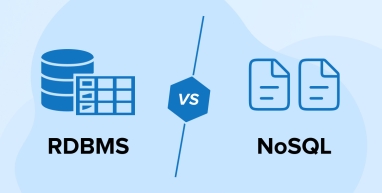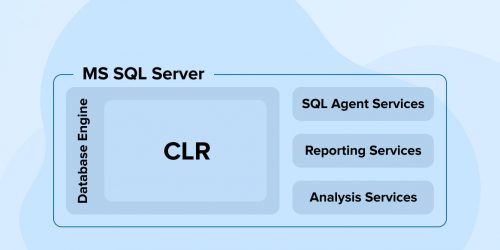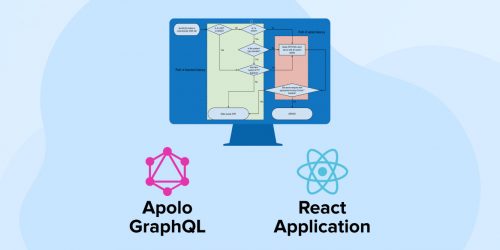Related Blogs

Relational and non-relational database management systems are the two primary categories of database systems. A software development company uses relational and non-relational databases according to their requirements. Relational databases are also known as SQL databases, whereas non-relational databases are called NoSQL databases.
In this blog post, we will learn about the differences between relational and nonrelational databases and discuss the features, pros, cons, and scenarios of using each database management system. In the end, you’ll also get a summarized comparison between them.
1. What is a Relational Database?
RDBMS, or Relational Database Management System, is the oldest type of DBMS. It stores data in tables (relations), which have rows and columns. The term relational refers to the logically interrelated tables in the databases based on some attributes. Programmers use SQL (Structured Query Language) to interact with the stored data in database tables. The columns or attributes denote the data type or type of information being stored, and the rows or records store the actual value of that type.
1.1 Features of RDBMS
The following are the key characteristics of relational databases:
- Acid compliance: RDBMS adheres to ACID (Atomicity, Consistency, Isolation, Durability) properties to maintain reliable database transactions even during system failures.
- Normalization: Data redundancy is minimized or eliminated through the normalization process.
- Concurrency Control: Multiple users can access the RDBMS as it supports it without compromising data integrity.
- Structured data storage: RDBMS organizes data into tables with predefined schemes that define the data structure.
1.2 Benefits and Drawbacks of RDBMS
Take a look at the advantages and disadvantages of RDBMS:
Advantages of RDBMS
- Data Security: RDBMS offers built-in security mechanisms such as user roles and permissions to ensure data access by authorized individuals only.
- Data Indexing: RDBMS supports clustered and non-clustered indexing for easily retrieving data from the database without scanning the complete database.
- Easy to Use: SQL is a comparatively easy-to-learn query language as its syntax resembles the English language. It’s easy even for a non-technical person to write and execute complex queries.
- Collaboration: The locking mechanism facilitates the collaboration of multiple users to operate simultaneously on the data.
- Backup and Recovery: Regular backups and data restoration help prevent data loss in case of data corruption or accidental deletions.
Limitations of RDBMS
- Scalability: Relational databases are generally vertically scalable, i.e., you need to increase the capacity of a single server, which is highly expensive and difficult to handle.
- Fixed schema: The predefined database structure requires modification in the application to alter the structure.
- Data Modeling: It’s tough to represent semi-structured data or unstructured data sets in a relational database, as it’s suitable only for structured data types.
- Data type limitations: SQL databases support built-in data types that do not include images or multimedia data types.
1.3 When to Use RDBMS with Real-World Examples?
Let’s delve deeper into relational databases by understanding the scenarios to use them:
- Structured Data: When data has a predefined schema, size, and relationships are clearly defined between entities, it is best suited to be organized in tables.
- Data Integrity and Consistency: Critical systems such as financial and e-commerce systems require high consistency and integrity in every transaction. Primary key and foreign key constraints ensure ACID compliance.
- Data Relationships: While modeling relationships between different entities, e.g., customers, products, and orders, RDBMS provides a robust framework for maintaining these relationships.
1.4 Real-World Use Cases of RDBMS
Following are the real-world use cases of RDBMS:
- Social Networking Platforms: Relational databases manage user accounts and relationships between users, content metadata, and recommendation systems by linking user profiles and their activities.
- Trading Systems: RDBMS stores different types of data related to stocks, bonds, options, futures, etc., facilitating real-time price updates and trade execution.
- Inventory Management: Relational database management systems help in tracking stock levels and product performance by linking categories, suppliers, inventory levels, and sales transactions.
2. What is NoSQL?
NoSQL or non-relational database is an alternative to the traditional database that used to deal only with the table structure. Unlike relational databases, it is built for unstructured or semi-structured data and does not use only tables for storing data.
NoSQL database systems are categorized into four types based on their data model:
- Document databases: They store data in documents in a JSON-like structure. The storage pattern is in the form of pairs, similar to key-value pairs. The values can be strings, numbers, booleans, arrays, or even other objects.
- Key-value databases: The data storage is in key-value pairs. Here, all the keys are unique and there is only one value for a particular key.
- Wide-column stores: The data is stored in columns across multiple servers or nodes. Here, the columns for a particular row aren’t fixed. Every row can contain a different number of columns. Multi-dimensional mapping is used to reference data by row and column.
- Graph databases: Data is stored in nodes and edges format, representing a graph-like structure. Nodes contain information, whereas edges store information about the relationship between nodes.
2.1 Features of NoSQL
The following are the key characteristics of non-relational databases:
- Distributed Computing: Data in NoSQL databases is distributed across multiple servers in a cluster, improving the accessibility of data for different purposes.
- Developer-friendly: You have a choice in terms of using APIs, query languages, and data manipulation tools for application development and integration.
- Dynamic schema: NoSQL databases have a flexible schema instead of a fixed schema in SQL databases, easing alteration in data structures without modifying the existing schema.
- High availability: The auto-replication feature of NoSQL systems ensures data availability even in case of any failures.
2.2 Benefits and Drawbacks of NoSQL
Take a look at the advantages and disadvantages of NoSQL databases:
Advantages of NoSQL
- Huge data storage: Complex data sets used in Big Data and IoT are unstructured data that can be easily managed with NoSQL databases.
- Agility: The flexible data model in NoSQL catalyzes agile development to enable developers to iterate quickly.
- Minimal downtime: The serverless and distributed architecture ensures robust functioning and reduced downtime if any of the nodes malfunction or fail.
- Integrated Caching: NoSQL supports in-memory caching, improving the application performance.
- Less Expensive: NoSQL databases are generally open-source and cheap. They do not require big servers to store and process data sets.
Limitations of NoSQL
- No support for complex queries: You cannot execute extensive joins on NoSQL databases, as they are distributed across multiple nodes, leading to inconsistent and slow results.
- Lack of maturity: Though NoSQL databases have become popular, they are relatively new and lack reliable standards, unlike relational databases.
- Low ACID compliance: There are fewer data integrity and consistency safeguards in NoSQL databases required for critical applications.
- Data relationships: Establishing relationships in NoSQL databases may be difficult, as it may involve denormalization.
2.3 When to Use NoSQL with Real-World Examples?
Let’s delve deeper into non-relational databases by understanding the scenarios to use them:
- Monitoring real-time data: NoSQL can handle unstructured data, making it suitable for applications that need to give immediate insights by analyzing large data sets of different types.
- For agile development practices: If there’s a need to develop prototypes and test new features before actual development, NoSQL is the best choice as there’s no redesigning of a database with every iteration.
- High read/write speed: Real-time data processing applications require rapid read and write operations that are not possible in the case of relational databases.
2.4 Real-World Use Cases of NoSQL Databases
Following are the real-world use cases of NoSQL databases:
- Content management: Content includes different kinds of data, be it texts, images, videos, animations, etc., from both the producer and user sides. NoSQL databases are deployed to manage all kinds of structured and unstructured data.
- Mobile applications: The huge amount of data generated from mobile devices worldwide requires voluminous read/write operations and consistency across all devices.
- Cybersecurity: Applications with NoSQL structure can collect insights about malicious activities from diverse topologies and respond proactively.
3. RDBMS vs NoSQL: Detailed Comparison
Let’s compare RDBMS vs NoSQL in detail.
3.1 Schema Flexibility
- Relational Databases: SQL databases use a fixed schema that cannot adapt to changing requirements and are not well-suited for unstructured or semi-structured data efficiently. Modifying the schema often requires downtime or complex migrations.
- NoSQL Databases: They have a flexible or schema-less design. This gives the flexibility of adding or removing attributes as per the needs without significant downtime.
3.2 Nature of Data
- Relational Databases: RDBMS is best suited for consistent and structured data. They organize data into rows and columns of a table, which helps maintain data integrity and consistency through defined schemas and relationships.
- NoSQL Databases: The schema-less design and variety of data models in NoSQL databases support the storage of unstructured or semi-structured data, such as hierarchical or nested data types.
3.3 Workload Volume
- Relational Databases: SQL queries are executed on a centralized server, and these queries can often be complex. Due to the need for strong consistency, relational databases cannot execute huge volumes of complex queries with high consistency requirements.
- NoSQL Databases: They are capable of processing huge data as they have multiple commodity servers distributed across different geographic regions.
3.4 Performance
- Relational Databases: They can process highly complex queries involving different kinds of joins and subqueries and ensure ACID (Atomicity, Consistency, Isolation, Durability) principles.
- NoSQL Databases: They can process tons of simple queries in a distributed environment at a very high speed. They prioritize horizontal scalability and high availability.
3.5 Scalability
- Relational Databases: RDBMS supports vertical scaling, which involves increasing the load-handling power of a single Microsoft SQL server to accommodate scaling requirements.
- NoSQL Databases: It allows horizontal scaling, which distributes the increasing traffic across multiple servers to ensure performance efficiency.
3.6 Storage Requirements
- Relational Databases: For optimizing storage, consider denormalizing data as a predefined schema in RDBMS often requires large storage. However, well-defined relationships facilitate easy denormalization.
- NoSQL Databases: The diverse formats of unstructured data limit denormalization, requiring specialized storage systems.
4. Tabular Comparison: RDBMS vs NoSQL
Let’s look at the summarized differences between relational and non-relational databases.
| Parameters | RDBMS | NoSQL Database |
|---|---|---|
| Data models | Structured and tabular format. | Key value, document, graphical format, etc. |
| Database performance | This can be increased with the addition of resources to the server. | It can be enhanced with the addition of more server nodes. |
| Failure | Single point of failure. | Multiple points of failure. |
| Transaction Support | Multi-row ACID-compliant transactions. | Different NoSQL databases support different levels of ACID transactions. |
| Query language | SQL queries to access the data. | Query language varies across different NoSQL databases. |
| Ecosystem | A mature ecosystem with huge support, tools, and resources. | Relatively new, hence less community support. |
| Data consistency | Strict data consistency due to strict adherence to ACID principles. | Data consistency eventually varies between various NoSQL databases. |
| Read/Write scalability | Read-only scalability. | Both read and write scalability. |
| Deployment | Deployed in a vertical manner. | Deployed in a horizontal manner. |
| Number of data sources | One or a few data centers. | Multi-data centers. |
5. Final Words
Today, we have a variety of database systems available in the market with varied features and functionalities. The existing traditional relational database systems are evolving to accommodate changing technological trends. Therefore, it’s obvious to get perplexed. The relational vs NoSQL systems debate is rapidly gaining ground in the software industry. The selection of an inappropriate database management system can have significant long-term consequences. Therefore, it is essential to do a proper requirement analysis and study the database systems available to fulfill your requirements. Two similar applications may implement different database systems. There’s even a possibility of using a combination of NoSQL and SQL database systems in the same project. It all depends on your project requirements, future scope, budget, resources, and many more.
You must be clear with the basic concepts of both relational and NoSQL databases and their underlying differences to make the best choice.
FAQs
What is the difference between RDBMS and NoSQL?
Relational databases store data in tables with predefined schemas, whereas NoSQL databases store semi-structured or unstructured data in documents, key-value pairs, and graph-like structures.
Why is NoSQL faster than RDBMS?
With increasing data volume, NoSQL database implements sharding, i.e., distributing the load on multiple servers for quickly processing the data. Also, the flexible schema eliminates schema validation overhead. Relational databases implement a rigid schema and centralized servers for handling data. Therefore, with increasing load and query complexity, the server capacity needs to be increased , which is difficult and costly.
What is the full form of NoSQL and RDBMS?
NoSQL is the abbreviation of “Not Only SQL” or “non-SQL”. RDBMS stands for relational database management system.

Vishal Shah
Vishal Shah has an extensive understanding of multiple application development frameworks and holds an upper hand with newer trends in order to strive and thrive in the dynamic market. He has nurtured his managerial growth in both technical and business aspects and gives his expertise through his blog posts.
Related Service
Custom Software Development
Know more about software development services
Learn moreAbout Custom Software DevelopmentSubscribe to our Newsletter
Signup for our newsletter and join 2700+ global business executives and technology experts to receive handpicked industry insights and latest news
Build your Team
Want to Hire Skilled Developers?




Comments
Leave a message...